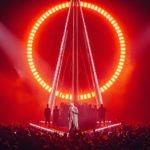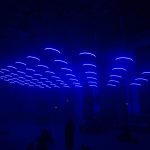 Several years ago I was on a job site completing a lighting design and programming a show when the producer asked me a great question: “How do you use color theory in lighting a show?”
Several years ago I was on a job site completing a lighting design and programming a show when the producer asked me a great question: “How do you use color theory in lighting a show?”
As the designer and programmer, I wanted to whip out an answer that would part the clouds and project a brilliantly illuminated beam right in the middle of his forehead and leave an indelible impression in his head. But the truth is that I was never trained as a lighting designer, and for some unknown reason they never taught us color theory in electrical engineering school. Still, I had to give him an answer, so, after pausing as long as comfortably possible, I opened my mouth and heard these words spill forth: “My theory is, whatever looks good—that’s what works.” Then I nervously turned back to my console and waited for the pointing and laughing to begin. I saw my entire design/programming career flash before my eyes and I thought I would certainly be asked to turn in my console keys. But he just kind of stood there with a confused look, as if he was seriously contemplating the answer. The conversation hung limp in the air.
Since then, that question has been haunting me, and, as good questions are apt to do, it has had me thinking and searching for answers. What “looks good”? When something looks good to me, do other people have the same or similar response? Is there something to color theory that could help me create universally better looks? Or does it suffice to say whatever looks good works?
After all, Vincent Van Gogh, one of the greatest painters ever, described his use of color as “arbitrary.” And he used color pretty darn well. Another great painter, Henri Matisse, was influenced by Van Gogh in his early years as a painter. In 1905, Matisse chaired a committee that put on a retrospective exhibition of Van Gogh paintings, and he said that Van Gogh’s paintings “encouraged him to strive for a freer, more spontaneous technique, for more intense, more expressive harmonies.”
Later that year, Matisse exhibited his work at the Salon d’Automne in Paris. One of his paintings, “Open Window, Collioure,” was painted that summer in Collioure, a small fishing village on the Mediterranean Sea in Spain. By this time, his use of color had evolved into a more structured approach. Where he had originally been using small strokes of pure pigment, he found the technique tends to make the colors appear dull because the eye views them as more of a blended color than of discrete colors. The result was that he was unable to achieve the brilliance he was looking for. Eventually he learned to use combinations of colors for maximum effect.
If you examine the painting you’ll notice how he has placed complementary colors bordering each other—red masts against blue hulls floating on pink waves below a blue and pink sky, framed by walls of violet and turquoise. This is a technique that was explored heavily by the neo-impressionist painters after a chemist named Michel-Eugene Chevreul discovered what he called the principle of simultaneous contrast. In simple terms, that means that when two complementary colors, such as red and green, blue and orange, or yellow and violet, are placed side by side, they appear to the eye to be much brighter.
Several years ago I saw U2’s “Zoo” tour, and it always sticks out in mind because of Willie William’s use of color. I distinctly remember how he combined orange-red and green in a way that would never occur to me to use. In retrospect I recognize it as a use of simultaneous contrast, and that’s probably why I have a very vivid memory of the lighting look. Audio techs are fond of saying that you don’t go home humming the lights, but believe me, the lights from that show are still humming in my head.
When I think back, every other show that I can vividly remember the lighting is also one in which simultaneous contrast was used. I remember seeing Fleetwood Mac at the Toyota Center in Houston and at the time I was very impressed with the yellow that the Vari*Lites could produce. When Stevie Nicks’ blonde hair was backlit with that color it was heavenly. I went back to look at the pictures, and what color do you suppose the yellow was set against? You guessed it—violet.
Did Willie Williams and Fleetwood Mac’s lighting designer, Paul “Arlo” Guthrie, know they were using simultaneous contrast? Perhaps. Perhaps not.
Johannes Itten, an art professor at the Bauhaus who was one of the pioneers of modern color theory, once wrote a book in which he answered my questions about color theory half a century before I asked it. In his book The Art of Color he wrote:
“In the realm of aesthetics, are there general rules and laws of color for the artist, or is the aesthetic appreciation of colors governed solely by subjective opinion? Students often ask this question, and my answer is always the same: ‘If you, unknowing, are able to create masterpieces in color, then un-knowledge is your way. But if you are unable to create masterpieces in color out of your un-knowledge, then you ought to look for knowledge.”
I lay no claim to the ability to create masterpieces, therefore I will continue to look for knowledge about color theory, and apply it to my lighting design work. I hope you will too.
What’s black and white and read all over? Your e-mail to the author. Send it to rcadena@plsn.com.


